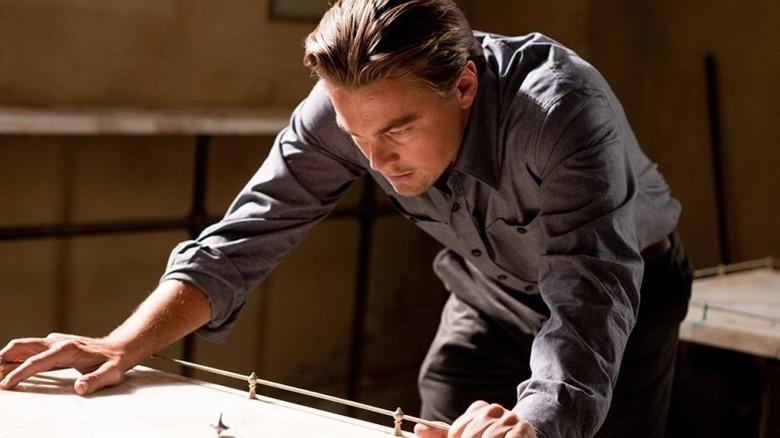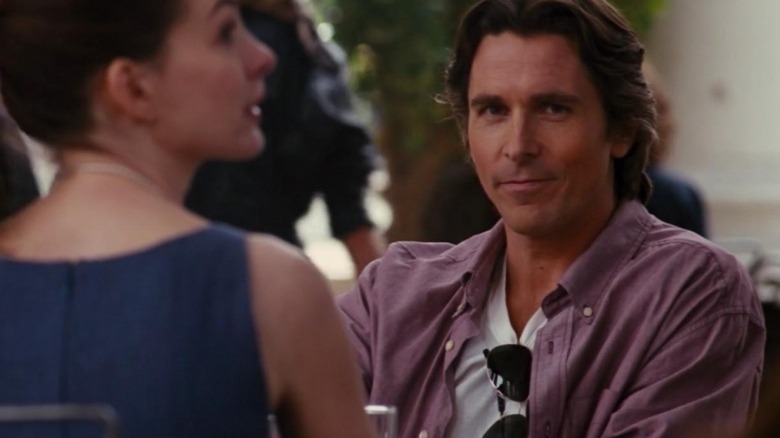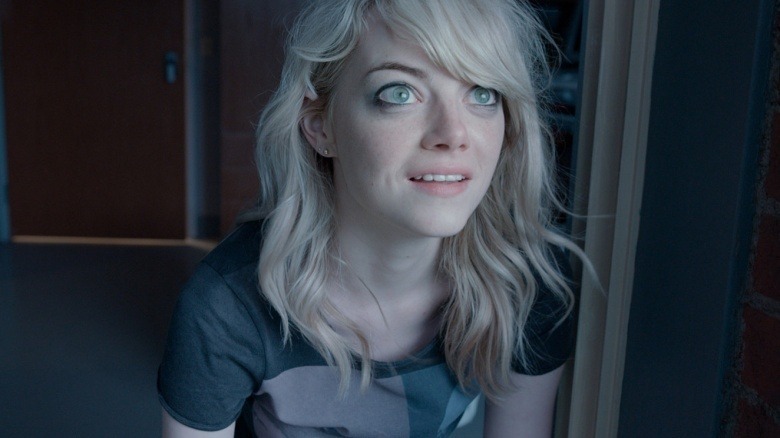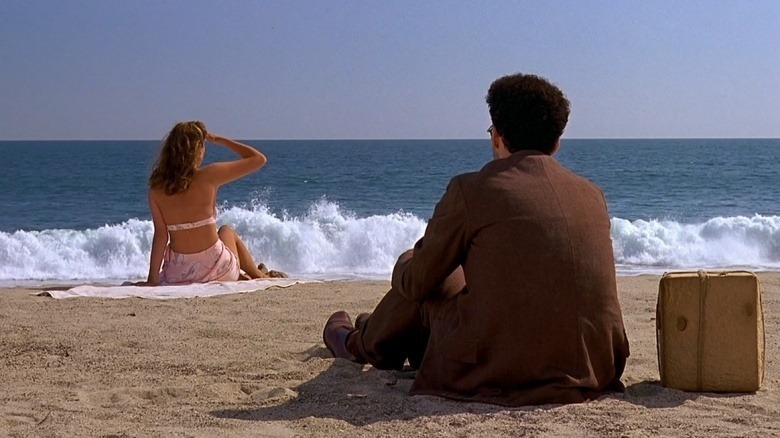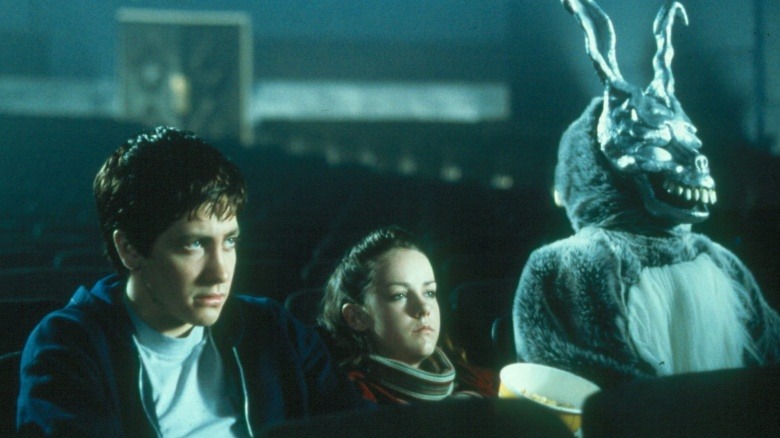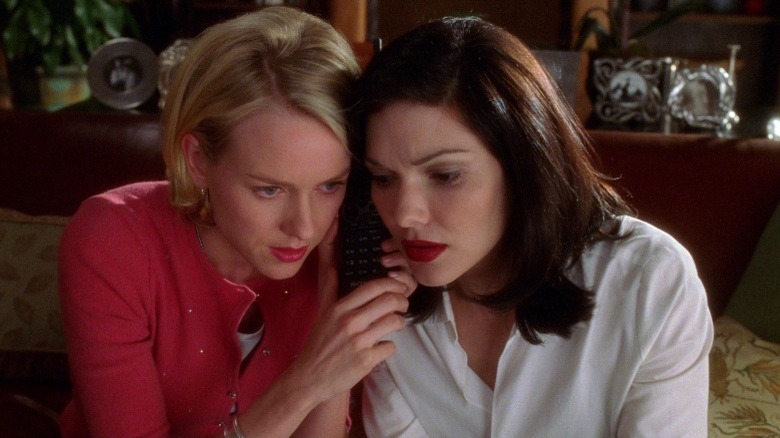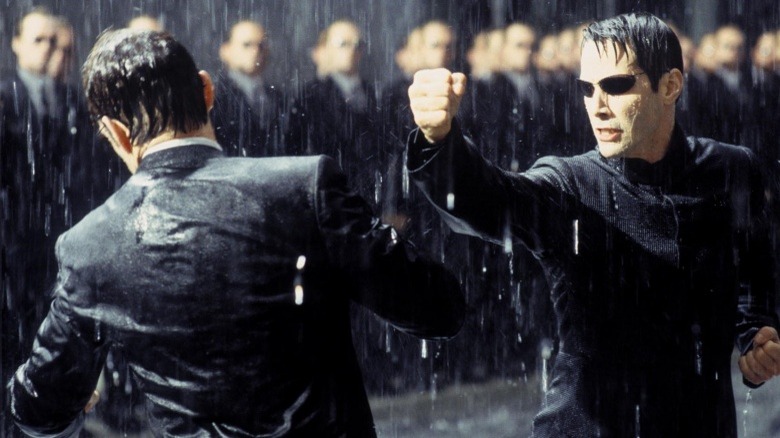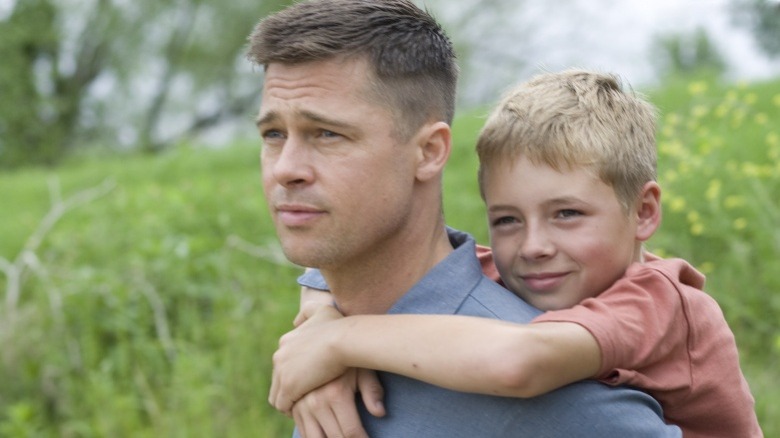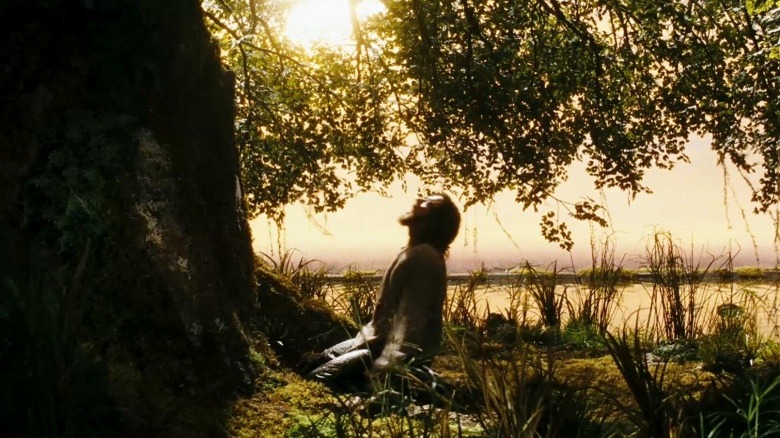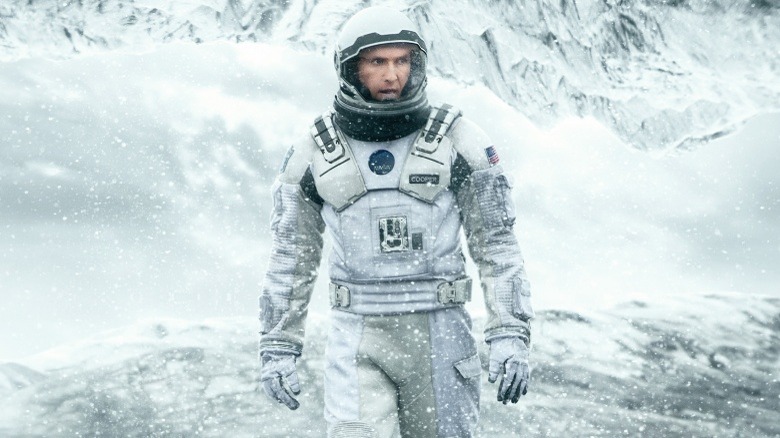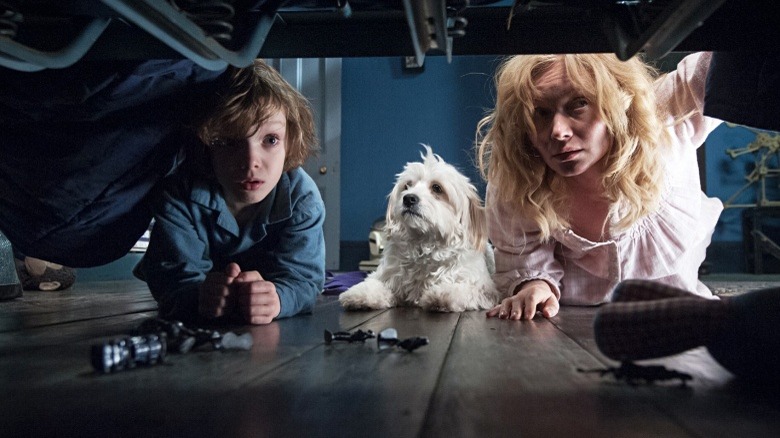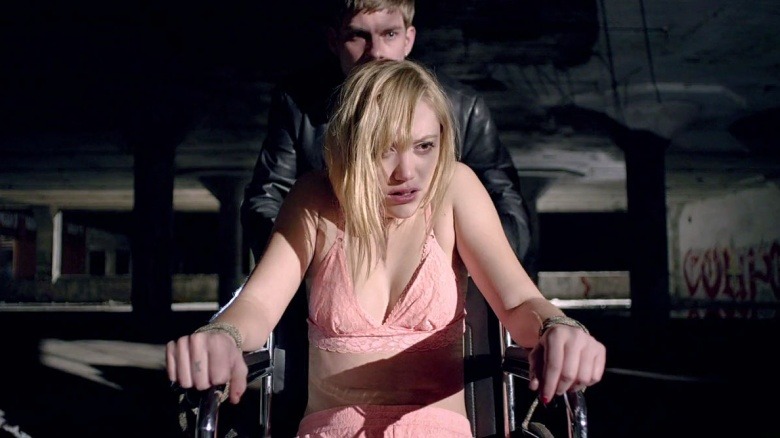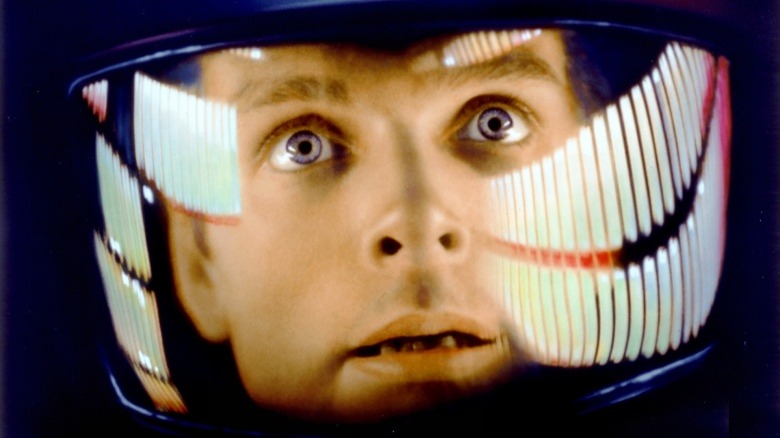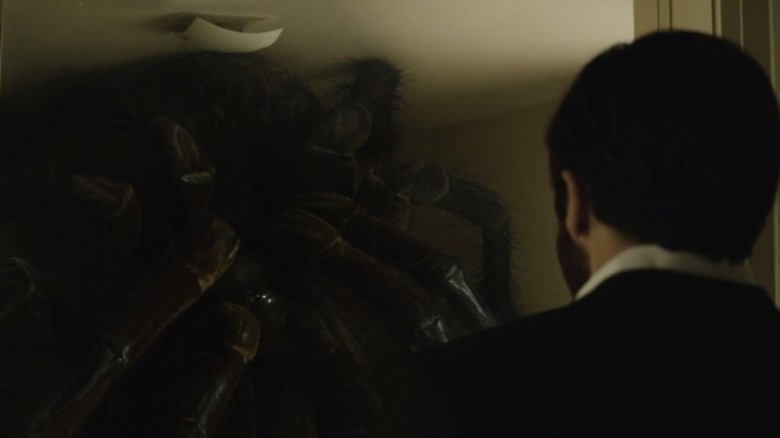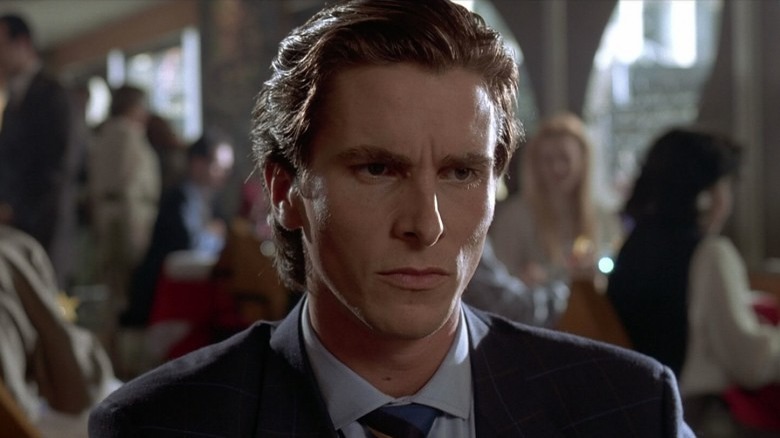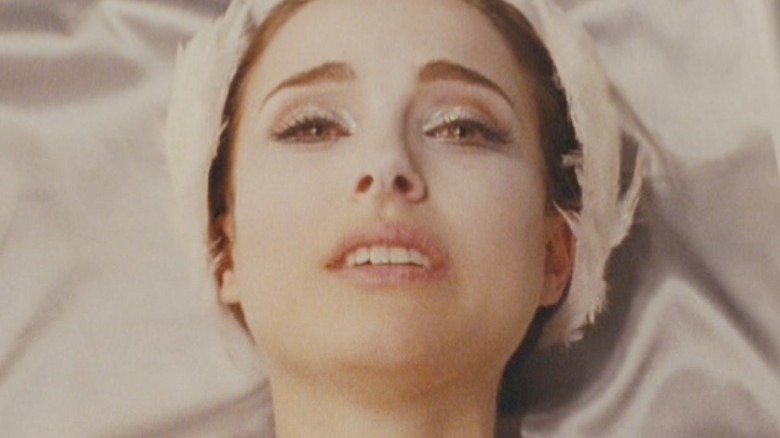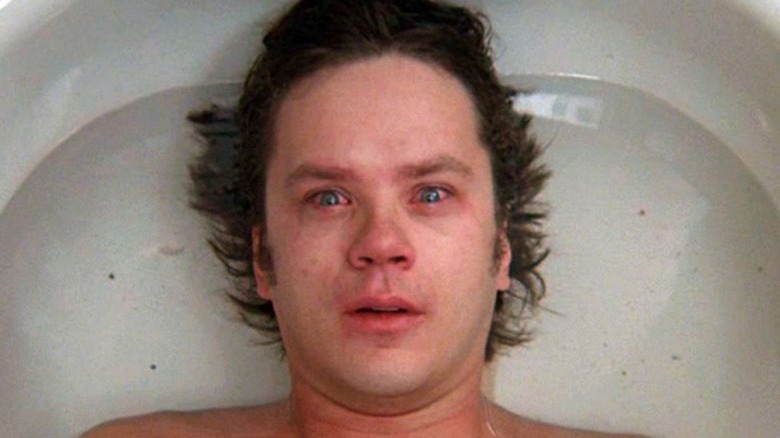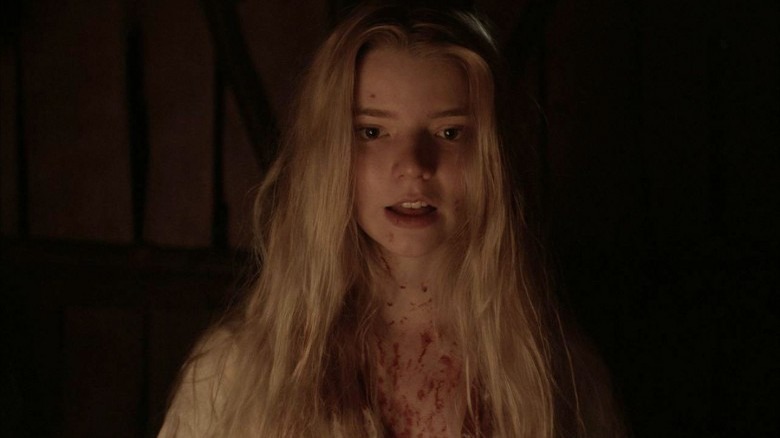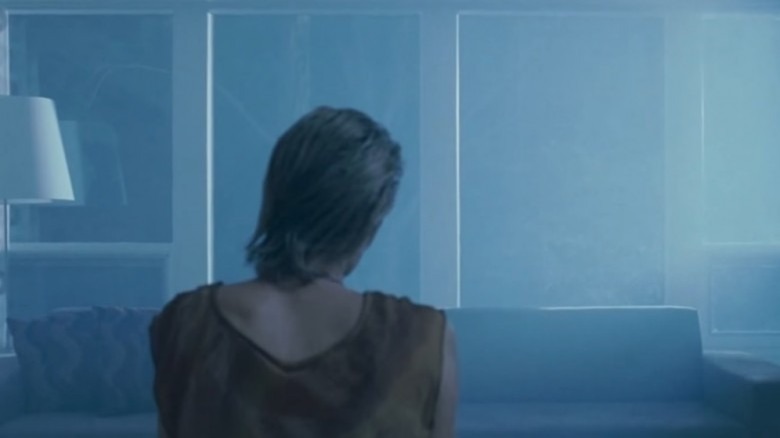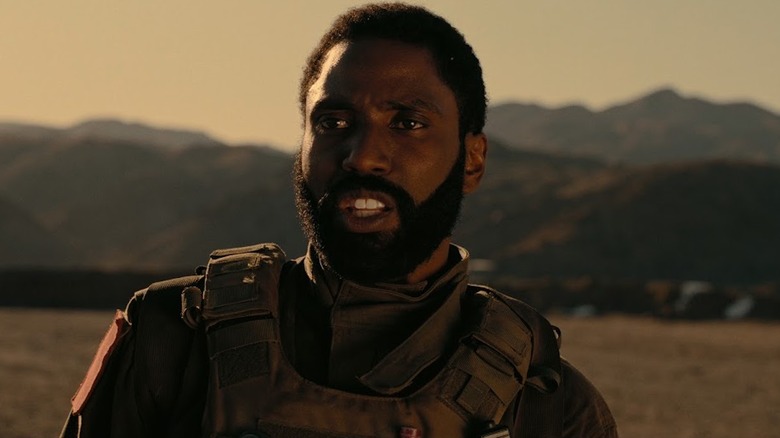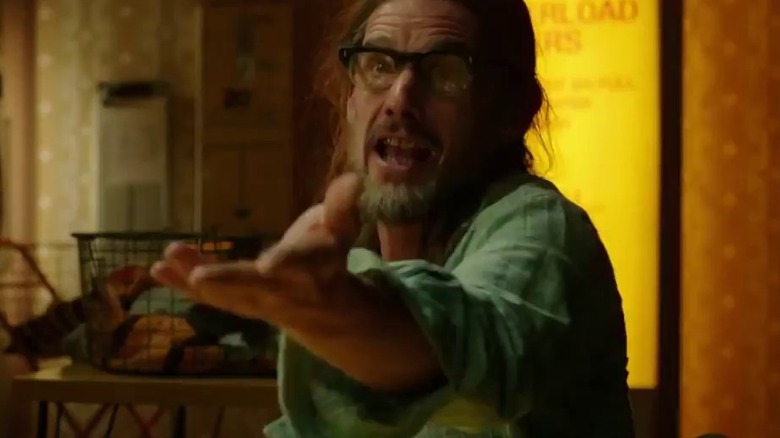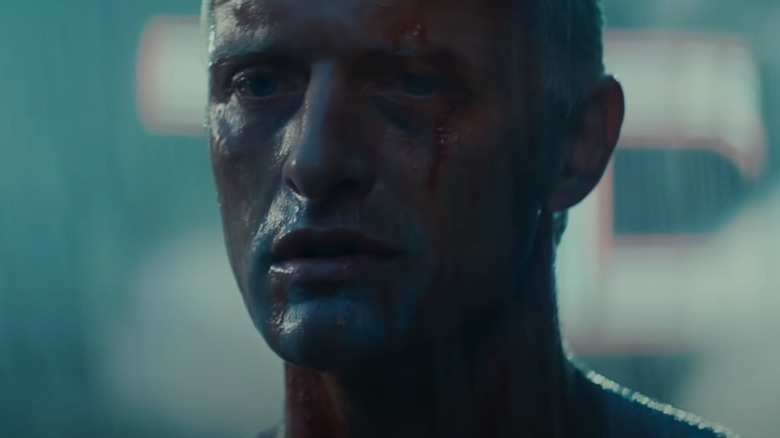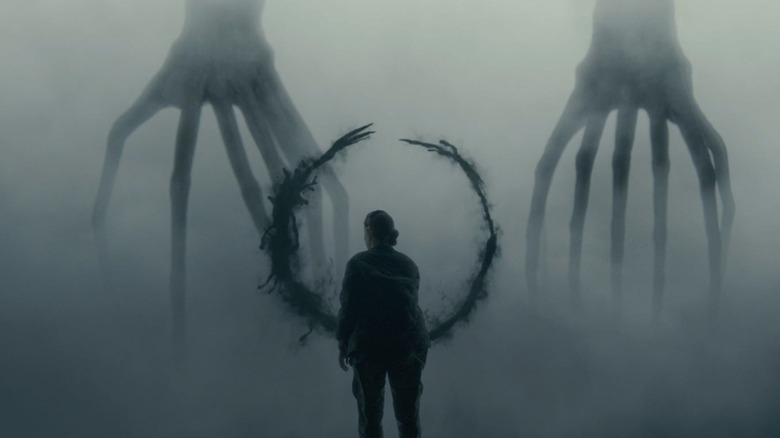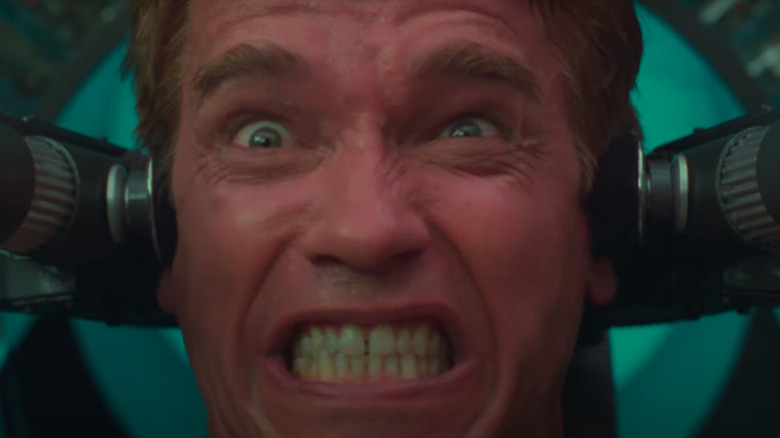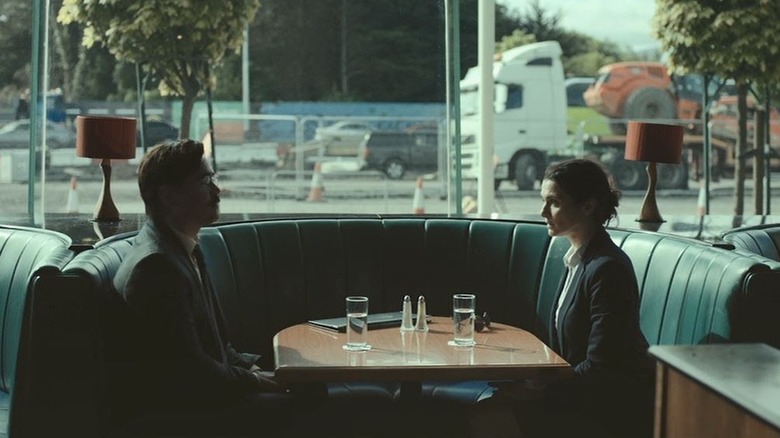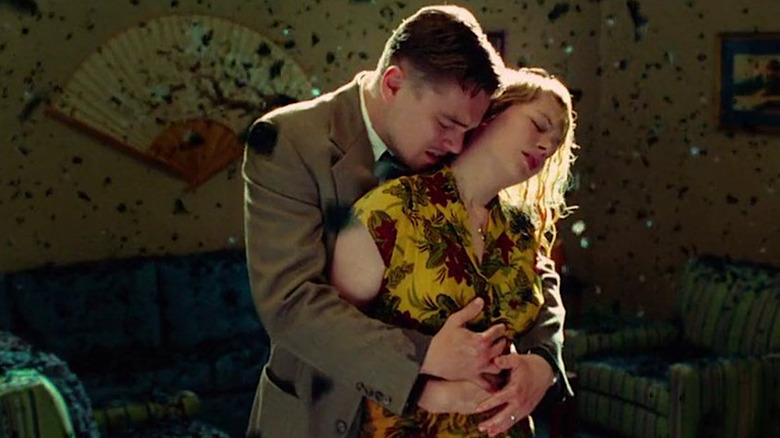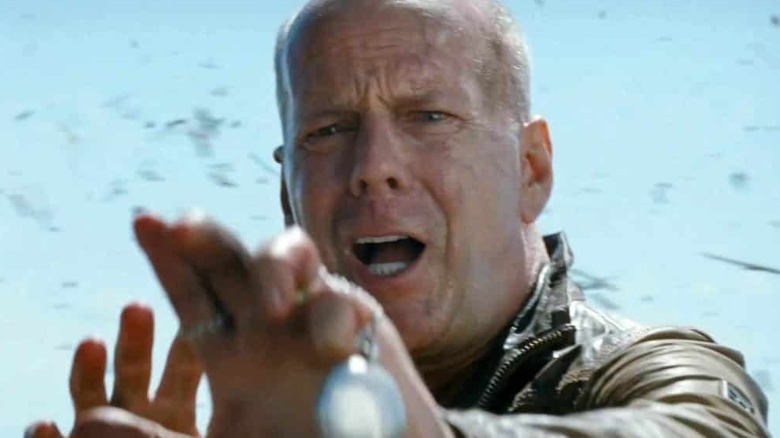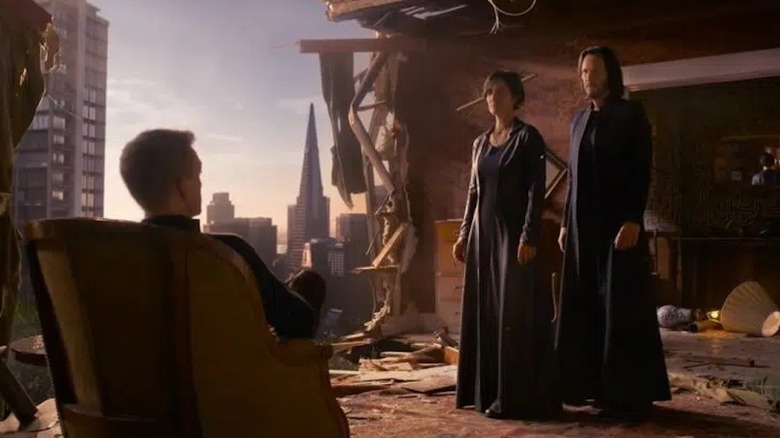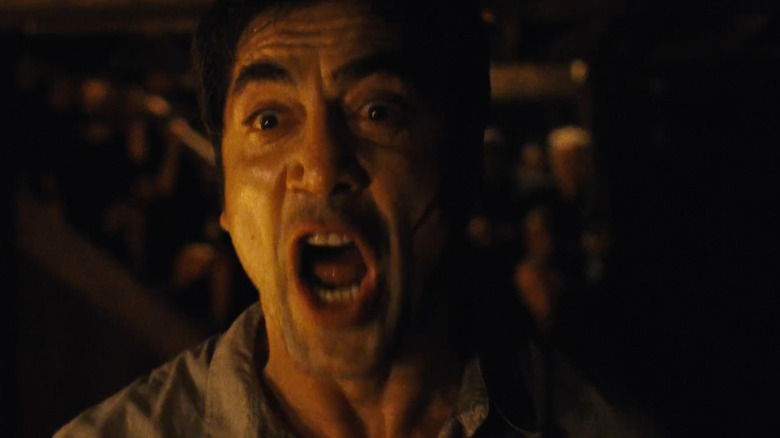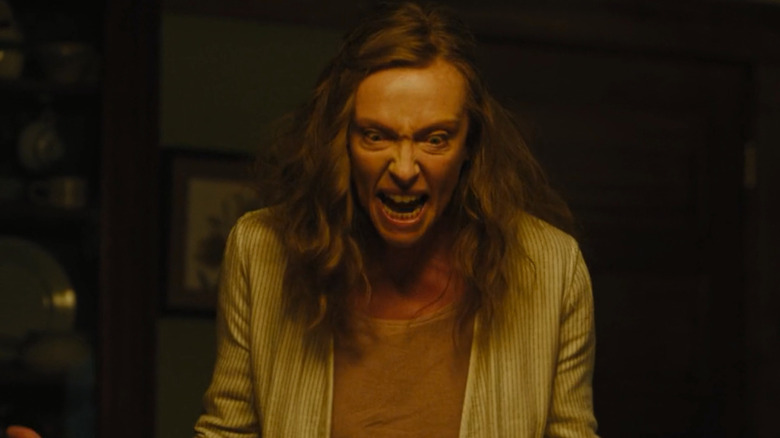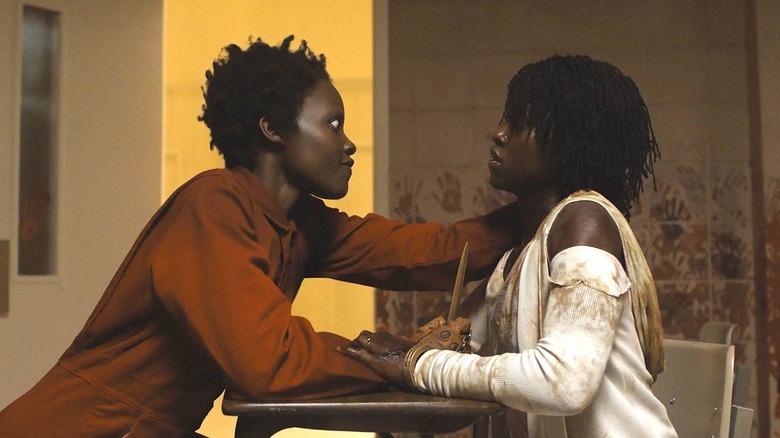The Real Meaning Behind These Confusing Movie Endings
Not all filmmakers like their movies to have simple endings. Some of the greatest visionaries in film history — from David Lynch to Christopher Nolan — leave their last scenes ambiguous every now and again to keep audiences thinking. Sometimes that plan backfires, resulting in endings that are just plain confusing. Other times, that plan works out pretty well; after all, do we really want our movies to clobber us over the head with how they want us to feel and think all the time? But just in case you need a little more clarity about one ending or another, we're here to lend a helping, de-mystifying hand.
Most importantly, beware of spoilers because, unlike the endings of some of these films, the title of this article is not meant to have a symbolic, non-literal meaning or be ambiguous in any way. We are absolutely giving the endings away to all the movies we discuss below.
Inception (2010)
Christopher Nolan's film left audiences' minds spinning as much as the top in the final shot. Just when it looks like the top is about to spin out and tumble, the screen cuts to black. The final shot shows Dom Cobb reuniting with his kids. But we never know if it's really happening or if it's a dream. Fans debated the scene endlessly for years after "Inception" came out ... but according to Nolan, the non-ending is actually kind of the whole point.
In 2015, the director gave the commencement speech at Princeton University, and told the grads to "chase their reality." He used the ending of "Inception" as an example, saying:
"[Cobb] was off with his kids, he was in his own subjective reality. He didn't really care anymore, and that makes a statement: perhaps, all levels of reality are valid. The camera moves over the spinning top just before it appears to be wobbling, it was cut to black."
In short, the ending of the movie is up to us — and we're right either way.
The Dark Knight Rises (2012)
The ending to Nolan's "Dark Knight" trilogy isn't as vague as "Inception." After flying a nuclear bomb out of Gotham City, Batman escapes the blast ... off-screen. We know this, because later, while Alfred is in Florence, he sees his former Master Bruce sitting at a table, enjoying a meal with Selina Kyle. Some fans have theorized that this is all a dream — that Batman actually died in the explosion, and that Alfred simply imagined seeing his friend taking in the Italian sunshine.
But that's bat-baloney. Before the movie's end, we learn along with Lucius Fox that Bruce Wayne fixed the Bat-plane's autopilot six months before the final showdown in Gotham. That's all the exposition necessary for viewers to know that Batman jumps out while the plane flies the bomb toward the bay.
And sure, when Alfred sees Wayne in Florence, it's exactly how Alfred describes it earlier in the film. But that's not a dream — it's just the best way for Wayne to show Alfred he's alive. Moreover, Selina Kyle is there, and Alfred wouldn't know she and Wayne ever became an item — he quit before Batman and Catwoman teamed up.
Finally, Christian Bale himself thinks that Wayne is alive by the end of the movie. He explained during an interview, "[Alfred] was just content with me being alive. And he left. Because that was the life he'd always wanted for [Bruce]. I find it very interesting. I think with most films, I tend to say it's always what the audience thinks it is. My personal opinion is that it was not a dream. That that was for real. And [Bruce] was delighted that he had finally freed himself from the privilege, but ultimately the burden of being Bruce Wayne."
Birdman (2014)
Alejandro G. Iñárritu's film about a washed-up actor trying to make a comeback on Broadway has the kind of weird ending that puts "Inception" to shame. Throughout the film, Riggan Thomson is shown as having superpowers, only to have them later be explained as being all in his head. In the final scene, Riggan's daughter Sam enters his hospital room to find his bed empty and the window open. Sirens and talking can be heard coming from the street below. Initially, Sam looks down, but she slowly turns her head to the sky, and she smiles. Some might think this means Riggan actually does have powers and flies away. Others think it means he successfully commits suicide, which he failed to do on the previous day.
One of the film's four screenwriters, Alexander Dinelaris Jr., hinted during an interview with HuffPost Live that the key to their understanding of the ending lies within Sam's relationship with her father.
"I think when we found the relationship with the daughter, we started to understand what Riggan's story was," he said. "Once she got down, Emma's big monologue, in the basement, we started to understand the relationship and what it was. We're not going to sit around and explain the ending. I guess my thing is, if you can silence the voice of mediocrity, then what is possible?"
If you or someone you know is struggling or in crisis, help is available. Call or text 988 or chat 988lifeline.org
Barton Fink (1991)
At the end of this Coen Brothers flick, Barton Fink wanders onto a beach where he meets a woman resembling the picture decorating his sparse, depressing hotel room. Shortly after they meet, the movie ends, potentially leaving some viewers scratching their heads. What's it mean?
The picture represents the idea of Hollywood. It's a place of fantasy, beaches, and beautiful women. Meanwhile, throughout the entire film, Fink is subjected to the reality of Hollywood. His script is torn apart by an executive; he finds out his hero, writer W. P. Mayhew is a washed-up alcoholic, and that Mayhew's wife writes his novels for him; to top it all off, Barton Fink flees from a burning hotel and a shotgun-wielding maniac.
You'd think that finally finding the woman on the beach would mean that Fink is at the end of his trials, having reached his reward and a place where he feels safe. But in fact, he's learned the truth about the dangerous world in which he now exists.
Joel Coen explained in a 1991 interview:
"Some people have suggested that the whole second part of the film is nothing but a nightmare. But it was never our intention to, in any literal sense, depict some bad dream, and yet it is true that we were aiming for a logic of the irrational. We wanted the film's atmosphere to reflect the psychological state of the protagonist."
Donnie Darko (2001)
There's "hard to understand" and then there's "Donnie Darko," Richard Kelly's cult classic mindbender about a suburban boy (Jake Gyllenhaal) who's visited by Frank, a mysterious figure in a rabbit costume and warned that the world will end in 28 days, 6 hours, 42 minutes, and 12 seconds. Frank's visit is followed by a jet engine crashing into Donnie's room, so it's understandable that Donnie starts acting erratically in the weeks that follow — but the ending, which finds him back at the start of the movie's timeline, laughing in his bedroom and waiting for the engine to drop in and kill him, is much more difficult to parse.
Reams have been written about the ending of "Darko" and its meaning, but the nugget-sized version is essentially this: Donnie was a sort of locus point for a tear in the space-time continuum, and although he spends much of the film unaware of it, his actions throughout the bulk of the film take place in an alternate universe where he's needed in order to set the universe straight, basically by arranging it so the jet engine ends up in his bedroom.
Mulholland Drive (2001)
David Lynch fans don't watch his work for straightforward narratives, but even in the context of his endearingly weird filmography, 2001's "Mulholland Drive" is tough to figure out. Lynch himself has steadfastly refused to help untangle the movie, which moves in jittery circles around an actress (Naomi Watts), a mysterious woman (Laura Elena Harring), and a film director (Justin Theroux) ... all of whom are mixed up in a dreamlike and frequently nonsensical series of events.
Ultimately, the movie's ending is every bit as open to interpretation as the rest of the film — and although viewers are welcome to delve into any or all of the many theories attempting to explain what Lynch might have meant by the whole thing, the best explanation was arguably posed by the late film critic Roger Ebert. "The movie is hypnotic; we're drawn along as if one thing leads to another but nothing leads anywhere, and that's even before the characters start to fracture and recombine like flesh caught in a kaleidoscope," he mused. "There is no explanation. There may not even be a mystery."
Matrix Revolutions (2003)
Our hero in "The Matrix" franchise, Neo (Keanu Reeves), is the only one with enough power to break the Matrix and save humanity. He spends the first two films on an apparent collision course with the near-invincible AI program known as Agent Smith (Hugo Weaving). But when their cataclysmic fight in the third installment finally arrives, Neo...gives up?
There are a lot of theories that attempt to explain the hows and whys of the head-scratcher ending of "The Matrix Revolutions," in which Neo lies on the brink of defeat until he realizes he doesn't need to beat Smith, but assimilate into the system — after which Smith is wiped out and the Matrix reboots under the dawn of a brand-new day. The best explanation is presented by the Matrix 101 fan site, which offers a detailed (and eventually rather moving) analysis that's far too long to break down here but boils down to this: Neo brokered a detente of sorts with the machines, allowing the continued existence of the Matrix "free zone" known as Zion while healing the corruption in the program personified by Smith. "This is a world where eradication of the enemy is seen for what it is: a symptom of the problem, not a solution," concludes the essay. "This is a world where the creator and its creation have the potential to live fruitfully in peace and cooperation."
The Tree of Life (2011)
For film buffs of a certain stripe, Terrence Malick movies are always an event. "The Tree of Life," which united a showy cast that included Brad Pitt, Sean Penn, and Jessica Chastain to tell a sort of memory play recounting the life of a Texas family, certainly fit the bill. Although the bulk of the story takes place in small-town 20th century America, it also makes room for the Big Bang and the creation of the Earth (including a couple dinosaurs) and ends on a ponderous note that finds its protagonist (Penn) standing on a beach that may or may not signify the afterlife.
One of Hollywood's foremost auteurs, Malick has never been in any real rush to explain his movies, and "Tree of Life" is no different. In fact, part of the fun of the film is trying to piece it together for yourself. If there's a "real" meaning, he hasn't seen fit to share it — and the panel of religious experts convened by the Los Angeles Times was unable to come up with any kind of consensus. Film critic Matt Zoller Seitz suggested that rather than telling a straightforward story, "[Malick is] opening up the top of his head and letting the memories and fantasies and personal anecdotes pour out, and arranging the pieces in such a way as to prompt you to remember your own life and reflect on it, and think about your own place in the cosmos, however small or large you may imagine it to be."
The Fountain (2006)
Darren Aronofsky's "The Fountain" features a trio of interlocking stories, each hundreds of years apart, all about a couple (played by Hugh Jackman and Rachel Weisz in each installment) coming to terms with being separated by death that culminates in a wild whatsit of an ending. In the movie's present-day timeline, a doctor named Tom labors feverishly to find a cure for his wife Izzi's brain tumor. She's written most of a book in which a Spanish conquistador searches for the Tree of Life at the behest of his queen; meanwhile, in the future, a cosmonaut heads for a distant nebula in a biosphere containing the Tree, interacting with Izzi's spirit along the way. It all ends in the cosmonaut's fiery death, the Tree's rebirth, and an ending in which Izzi's spirit hands Tom fruit from the Tree ... which he plants in her grave.
It's all deeply symbolic, obviously, and anyone hoping for a literal explanation out of "The Fountain" will be somewhat frustrated. But it's acquired a growing cult following over the years among viewers willing to puzzle with what Aronofsky admitted is a "Rubik's cube" of a story. He told AICN:
"There are ideas in there that I believe, but I think I wanted to leave it open, so that anyone can bring their own beliefs to the table, and that it could awaken them, and people can have a conversation. Just like when we all used to sit around in college, or wherever, with friends just bull****ting about, you know, 'What is the world and why are we here?' That's what this film is."
Interstellar (2014)
Christopher Nolan's sci-fi epic "Interstellar" is a lot of things, but easy to understand isn't necessarily one of them. Astronaut Joseph Cooper (Matthew McConaughey), on a desperate mission to find a new home for humanity, plummets into a black hole and drifts beyond the event horizon, finding himself inside a tesseract where he's able to see inside his daughter's bedroom at any point in her life. He communicates with her through gravity, thus guiding her to unlock the equation that helps humanity escape Earth.
It gets even more trippy after Cooper is discovered floating through space and meets his dying daughter, who's aged at normal speed while he's been on his intergalactic travels and is thus much older than he is. So, what's Nolan trying to tell us?
The gist of the whole film rests on the notion that time is a circle, and the possibility of a "bootstrap paradox" — a theory explained by Slate with a comparison that fans should appreciate:
"In the first ["Terminator" movie], Kyle Reese is sent back in time by John Connor to protect Sarah Connor, John Connor's mother. The paradox is that Reese turns out to be the father of John Connor — by sending Reese back in time, John Connor created himself."
Back to "Interstellar": the tesseract Cooper entered was created by future humans who'd been saved by the work done by his daughter ... so they gave him an opening through time and space so he could give her the knowledge she needed to finish her work. Hey, look, sometimes the explanations are just as confusing as the endings, okay?
The Babadook (2014)
Unlike a few of the movies on this list, figuring out "The Babadook" isn't that difficult — provided you keep up with the sudden change in perspective in the final act. For much of its running time, this indie horror hit looks and feels like a particularly satisfying supernatural home invasion picture, with the titular nasty creature tormenting a single mother (Essie Davis) and her 6-year-old son (Noah Wiseman) after he's inadvertently summoned through the reading of a disturbing children's book. But there's more going on beneath the surface. In the film's closing scenes, after the Babadook has possessed Davis' character and she tries to strangle her son, he draws it out of her with a tender expression of love — at which point the Babadook flees into the basement where she's stored all mementos of her husband since his death.
That's when we realize the creature wasn't supernatural at all — it was her years of repressed grief, which had grown so powerful it threatened to destroy the lives of everything it touched. In a perfect blend of heartwarming and gross, the closing moments of "The Babadook" show mother and son gathering a bowl of worms, which Davis takes into the basement to feed the vanquished beast — tacitly acknowledging that she'll always carry it with her and honor its place in her heart.
It Follows (2014)
Being chased is pretty scary, but being pursued can be worse. That's the feeling that suffuses "It Follows," David Robert Mitchell's suburban horror movie about a girl named Jay (Maika Monroe) who has a seemingly ordinary hookup only to realize she's been infected with a sexually transmitted ghost.
Jay's told the only way she can escape the evil spirit (which haunts her in some truly terrifying ways) is by sleeping with someone else to pass it on. One thing leads to another, and ultimately, she and her friends try killing it, with generally unpleasant (not to mention ambiguous) results. After the climactic conflict, Jay and her friend Paul (Keir Gilchrist) have sex ... and later, Paul's seen driving past a group of prostitutes. In the film's final shot, the duo walk down a street while someone (or something?) follows behind.
Like plenty of thought-provoking cinema, much of "It Follows" is open to interpretation. Mitchell has only hinted at his personal point of view on the scene depicting the spirit's possible "death," but he's made it clear that he never set out to make a movie with a literal meaning, or one whose antagonist's motives were ever explained. As he's said in multiple interviews, he was originally inspired by a nightmare in which he knew he was being followed, knew he couldn't get away, and knew the people with him in the nightmare weren't able to help him. As for the ambiguity of that last shot? Totally intentional. As he told Vulture, "It allows people to make up their own mind of what it means."
Vanilla Sky (2001)
"Vanilla Sky" was definitely not the movie Cameron Crowe fans were expecting to see when they filed into theaters in December of 2001 –especially not with Crowe's "Jerry Maguire" leading man Tom Cruise looming large on the poster. Instead of a feelgood romance or a fun coming-of-age story, they got a moody, elliptical remake of a hit Spanish film. A feckless playboy (Cruise) suffers near-death and disfigurement after his relationship with his new girlfriend (Penélope Cruz) plunges his ex-lover (Cameron Diaz) into homicidal obsession. He spirals into depression, has his face surgically restored, and then his life really starts to go haywire.
Ultimately, viewers are told that much of what they've seen is a lucid dream in Cruise's brain, which has been held in cryonic stasis for more than 100 years, and that the more troubling elements of the narrative are the result of a glitch. He's given the choice to either reboot the dream or exit it once and for all by jumping off a building and being brought back to life. He jumps — and the last shot is of Cruise's character opening his eyes, starting his life over again.
There are lots of interpretations for all this, some of which were supplied by Crowe himself in the commentary track for the DVD, but the correct one might just be accepting what you see onscreen as the actual events of the story. Crowe seemed to lean that direction while talking with Film School Rejects about the unused alternate ending:
"You want people to understand what you're going for, so the question is, looking at both endings: Did the pendulum swing too much in the direction of us explaining stuff? I think it did. The original ending was more open-ended, a little less explained."
2001: A Space Odyssey (1968)
There's an entire website (complete with four-part video) dedicated to explaining the ins and outs of Stanley Kubrick's 1968 sci-fi classic, and we couldn't possibly get into even a fraction of the analysis that's been devoted to the movie in the decades since its release. What we can do is offer Kubrick's own assessment of the ending, in which astronaut Dave Bowman (Keir Dullea) comes into contact with an extraterrestrial monolith and goes through a bizarre succession of experiences — vast space travel, seeing himself at different ages, and finally being transformed into a floating space fetus. Even for the late '60s, it's pretty nutty stuff.
"In a timeless state, his life passes from middle age to senescence to death. He is reborn, an enhanced being, a star child, an angel, a superman, if you like, and returns to Earth prepared for the next leap forward of man's evolutionary destiny," Kubrick explained, as revealed in the book "Stanley Kubrick: Interviews." "That is what happens on the film's simplest level."
In the next breath, however, he pointed out that "2001" concerns itself with "elements of philosophy and metaphysics" that "have nothing to do with the bare plotline," so whatever Kubrick's summary tells you about Bowman's fate, you can trust there's more to it — and that any extra meaning is entirely up to you.
"The film becomes anything the viewer sees in it," he continued. "If the film stirs the emotions and penetrates the subconscious of the viewer, if it stimulates, however inchoately, his mythological and religious yearnings and impulses, then it has succeeded."
Enemy (2013)
"Enemy" follows Jake Gyllenhaal as Adam, a history professor who discovers the existence of his exact double. The story feels like a particularly menacing dream, and at no point is this more evident than when the movie ends with Gyllenhaal walking into his bedroom ... to find his wife has turned into a giant spider. It's incredibly disorienting — there's a reason audience reviews of the film are so divided. But don't confuse it for randomness — there's deeper meaning at work here.
"It's a movie that is set to a game," said director Denis Villeneuve. "It's not something that gives answers. It creates a lot of questions in your mind, but it's set like a puzzle." To solve this puzzle, focus on two keys: Adam's opening lecture on dictatorships, and the meaning of the spider.
Villeneuve has hinted that the real enemy in "Enemy" is "the dictator inside ourselves," and the opening monologue is entirely about how dictators distract subjects from their problems with the entertainment of "bread and circuses." Couple this with Villeneuve's suggestion that both protagonists are "maybe two sides of the same persona," and you realize the mystery of the double just may be an invention of the dictator in Adam's mind. And what problems is the hero distracting himself from? The women in his life, represented in his mind by spiders.
American Psycho (2000)
Based on a novel from Bret Easton Ellis, "American Psycho" is a satirical horror story about the inner life of Patrick Bateman, a high-paid investment banker in 1980s New York. He's also, if you believe his inner monologue, an unhinged serial killer and sadist. His job as an executive is no coincidence. A major theme of the story is to ridicule the self-centered "greed is good" mindset of the decade and make fun of the high-powered players of the finance world who embody that ethos the most.
Everyone around Bateman is as horrible as he is, save for the murderous tendencies — and Bateman may not even be a real murderer. His body count is called into question as the story progresses and Bateman frequently experiences things that aren't real. (The ATM that says FEED ME A STRAY CAT and the shootout with police that follows, for example.) An air of "did that really happen?" hangs over the entire story, until the only thing that's truly clear is that Bateman is utterly insane.
Following a night of murder, a police manhunt, and a confession to his lawyer, Bateman attends a social occasion to find that nothing's changed. Either he's done nothing, or his crimes have been of so little interest to his peers that they haven't caused a single ripple. By the end, the question of whether Bateman's murders really happened is irrelevant — no one would have noticed either way. There are no consequences to his actions, "even after admitting this." The movie ends as Bateman says: "There is no catharsis."
Black Swan (2010)
Deciphering the ending of "Black Swan" starts with comparing it to the ending of director Darren Aronofsky's previous film, "The Wrestler." Both films are natural companion pieces that Aronofsky says were originally conceived as the same movie. "The Wrestler" ends on a tragic note, cutting to black as its hero leaps into the ring, choosing to die doing what he loves — either right then, or one day soon. "Black Swan" fades to white as Nina lies bloodied on the mattress backstage is a little more ambiguous, but still tragic, as Nina chooses her performance over herself. While we don't know if she literally dies after her performance, she's given herself entirely to the role. It's a kind of ego death, or death of innocence, that she'll probably never come back from. To become the vessel for a perfect black swan, she loses her sanity, and loses herself. But oh, what a beautiful performance. "Perfect," she says at the end, her goal achieved. "I was perfect."
Jacob's Ladder (1990)
"Jacob's Ladder" follows the last days of a war veteran and postal worker named Jacob Singer as his reality becomes completely undone at the seams, invaded by demons and hellish visions. Midway through, he meets a scientist who once worked with the military to experiment on soldiers with psychedelic drugs meant to put them into killing frenzies. He takes this as the explanation for his visions, but the ending of the movie reveals the truth goes even deeper.
Similar to the 1890 short story "An Occurrence at Owl Creek Bridge," "Jacob's Ladder" is about the last dream of a dying man killed by fellow soldiers in an unexplained attack. Perhaps the reality of the film is his mind attempting to figure out why he was gunned down, to sort out a meaning for his senseless death. The opening of the movie wasn't his past days in Vietnam — it was the last day of his life. As the movie ends, he expires on the battlefield, his tormented journey through Vietnam, and his mind, fractured by war, over at last.
So why the hellish visions, and why at the end do they turn more peaceful, with Jacob ascending into heaven with his son? Jacob's chiropractor, Louis, who serves as his guardian figure in the movie, explains to him that if you resist death, and try to hold on, "you'll see devils tearing your life away. But if you've made your peace, then the devils are really angels, freeing you from the Earth. It's just a matter of how you look at it."
The Witch (2015)
One of the wisest scripting moves made by this fantastic movie is making it clear at the very beginning that yes, there really is a witch in them there woods. Unlike many films that court a certain air of ambiguity, "The Witch" makes its supernatural content explicit — instead of having to wonder if it's really happening, you can just sit back and wonder what it means.
In the end, Thomasin's family has been devastated by infighting and madness stoked by provocations of the evil in the woods, resulting in the death of her father, and leading her to kill her own mother in self-defense. Lost and terrified, she becomes susceptible to the manipulations of Black Phillip, a demonic character who seems to be a high power of dark evil. He convinces Thomasin to follow him into a world unrestrained by the Puritanical values that her domineering father preached, offering an alternative to holy penitence and self-denial — "wouldst thou like to live deliciously?" Impressionable and lost, Thomasin swears allegiance to Black Phillip, and joins his coven of witches in the woods. She becomes powerful, she becomes, in her mind, free — the only cost is her mortal soul. Who knows if she'll one day live to regret it — as the movie ends, she embraces the hedonistic freedom of Black Phillip's cult.
Silent Hill (2006)
The "Silent Hill" series of movies and games presents the idea of an "otherworld" beneath our own, where physical spaces remain mostly the same, except they're covered in rust, blood, and populated by demons. But separating the real world and that otherworld is a misty in-between where humans and the monsters can cross paths. Initially, this foggy reality is only confined to the town of Silent Hill, but as the movie ends, Rose and her adopted daughter Sharon remain in the mist even as they leave town and return home. Christopher, Rose's husband, seems to sense their presence, but they occupy different planes of reality — recall the sequence when Christopher and Rose couldn't see each other as he searched for her in Silent Hill, despite occupying the same hallway in different dimensions.
The implication is that a part of whatever evil has infected the town has followed Rose and Sharon home, keeping them in this cloudy purgatory, likely through Sharon. Sharon is, essentially, another part of Alessa, Silent Hill's girl-gone-bad who was burned as a witch and sought supernatural vengeance on the town that killed her. Though Alessa appears defeated at the end of the film, her essence lives on in Sharon, in a world beneath reality that has now followed her beyond the borders of the town. Director Christophe Gans explained his take on the series' mythology in 2006, saying, "Here we are dealing with a character who has the capacity to split, and when you realize that Alessa is no longer one character, but many, it explains the story of the town. It's interesting because the town itself mirrors this fractured psychology — different dimensions, different doubles of the same person."
Tenet (2020)
Director Christopher Nolan has a reputation for making his movies confusing and dispensing parts of his stories out of sequential order. This culminated in his 2020 sci-fi thriller "Tenet," which centers on the eponymous intelligence agency that has discovered inverted objects — and even people — that can move backwards in time. Their latest mission, led by an unnamed protagonist (John David Washington) is to stop a dangerous terrorist who it's believed is communicating with an ally in the future, and if he's not stopped, could start World War III ... or worse.
The Protagonist recruits fresh-faced agent Neil (Robert Pattinson) and in the climax they split into two teams — one moving forward in time and one backward — to save the day. It's all pretty exciting, time-bending stuff, and as the action unfolds, we see not one but two different versions of Neil. But how can that be? As it turns out, Neil isn't exactly a new recruit. He's actually been working with the Protagonist in the future, though he doesn't necessarily realize it in the present. The second Neil is his future self, uninverted in time.
To make things even more confusing, we also learn in an epilogue that it's the Protagonist who founded the Tenet agency in the future and has been communicating with the past. And he set the entire chain of events in motion by recruiting himself from the past into the organization that he would later create — forming a temporal causality loop. If you're still confused, we're not surprised: "Tenet" is one movie that is tough to grasp even for the most seasoned fans of time travel stories and doesn't necessarily hold up to serious scrutiny.
Predestination (2014)
Like "Tenet," "Predestination" is the story of an unnamed time-traveling agent, here played by Ethan Hawke. He's on the hunt for a time-hopping terrorist called the Fizzle Bomber while undercover in the 1970s. There, he meets John (Sarah Snook), who works for a secretive government agency.
By the end we learn that Hawke's agent character is actually a future version of Snook's John, who was born Jane and later underwent female-to-male surgery. The twists go further because we also discover that Hawke's agent — having been given a new face after a devastating injury — had been recruited by the clandestine Temporal Bureau. On one of his first missions, he went back in time to when he was still Jane, fell into a romance with his young self, and fathers his own baby. If you think that's confusing, we're just getting started, because when the baby is born, Hawke's agent steals the child and delivers it to the doorstep of the very orphanage he grew up in as Jane. That's right: The agent isn't just a future version of Jane but is also his own father ... and mother.
But wait: There's more. When Hawke's agent tracks down the Fizzle Bomber, he's shocked to find that it's his own future self, having gone mad from too much time travel. The bomber (also played by Hawke) even claims he's not a villain — his acts of terrorism are actually saving lives. And if the agent is to stop him, he'll have to kill his future self, which ironically will cement his transformation into the Fizzle Bomber. Of course, the most ominous implication is that the Temporal Bureau orchestrated the agent's very creation.
Blade Runner (1982)
A groundbreaking sci-fi classic, "Blade Runner" may not have been so confusing when it was first released in 1982. Famously the victim of studio interference, its original version was more of a straightforward cyberpunk thriller about a Rick Deckard (Harrison Ford) whose job is to hunt down fugitive androids called replicants. Over the next two decades, though, expanded versions of the film, including a comprehensive director's cut, added elements that made the ending something else entirely, creating confusion for audiences that has lasted more than 30 years.
Beginning with one of those expanded editions, new footage was included that suggested that Deckard was far more than just a future law enforcer. Because in a newly added sequence, Deckard dreams about a unicorn, and when the character Gaff (Edward James Olmos) leaves an origami unicorn behind, it suggests that he's been able to access Deckard's artificially implanted memories — meaning that Deckard is actually replicant himself.
Over the years, the film's director, movie critics, and even its star Harrison Ford, have all had different takes on what the new ending really meant and whether Deckard was a human or not. The long-awaited sequel, "Blade Runner 2049" directed by Denis Villeneuve, glosses over the issue, leaving diehard fans to continue the debate on Deckard's identity. While Villeneuve prefers to leave the interpretation up to the viewer, the franchise's creator Ridley Scott answered the question himself in an interview with Digital Spy, saying bluntly, in no uncertain terms, "He is definitely a replicant."
Arrival (2016)
Before he helmed "Blade Runner 2049," director Denis Villeneuve sat behind the camera for the psychological sci-fi drama "Arrival," starring Amy Adams and Jeremy Renner. The story of mankind's first contact with extraterrestrial life, the movie centers on grief-stricken mother Louise Banks (Adams), whose daughter dies early in the film. Banks also happens to be a linguist, and she's been tasked with finding a way to communicate with the visitors from the stars. But what's not so readily apparent is that "Arrival" is another story that confuses audiences with the use of time travel, though in a rather unusual way.
While it can be a little difficult to parse, the story reveals that the aliens do not experience time in the same linear fashion humans do; they have an ability to see the future as easily as we can remember the past. By learning their language, Banks is able to tap into their ability to recall future events, and in doing so is able to make sense of the tragedy of her daughter's death. Meanwhile, Banks' partner in the project, Ian Donnelly (Renner), becomes close to her, and the two dance around their feelings for one another.
The film's ending reveals that Banks' daughter didn't die at all — she hasn't even been born yet. Banks, having learned the alien language, knows of her own future, which will see her marry Donnelly and give birth to a daughter, who she knows will die at the tender age of 12, prompting Donnelly to leave her. But even knowing the tragedy to come, Banks chooses to allow the future to unfold as she has seen it.
Total Recall (1990)
Adapted from the short story "We Can Remember It For You Wholesale" by sci-fi luminary Philip K. Dick, "Total Recall" ditched the source material's more cerebral story in favor of action spectacle once Arnold Schwarzenegger was cast in the lead role. That doesn't mean it's not without its more thought-provoking elements, though, and the ending leaves audiences with plenty to think about.
It all starts with blue-collar worker Douglas Quaid (Schwarzenegger) deciding to pay for implanted memories of an exciting adventure on Mars where he plays the role of secret agent. The problem is, before he can undergo the procedure, he suddenly finds himself hunted by dangerous thugs and realizes that he may actually be a deadly super-spy, whose memories have been wiped for his latest undercover mission.
Throughout the adventure, Quaid doesn't know what to believe: Is he actually an undercover operative working for a ruthless tyrant? Or is he an ordinary man and everything he's experiencing is just some kind of implanted delusion? There's evidence for both sides of the debate. But looking at it closely, it becomes clear that, to the surprise of many, the entire film is actually just an implanted memory, and Quaid is probably suffering an embolism and is unable to wake from his dream world. In addition to plenty of on-screen clues, director Paul Verhoeven, in his commentary on the DVD release, confirms his belief that the adventure was all a false reality. "The dream really starts at the moment that he falls asleep. So the next scene, which seems to be a [malfunction] of the machine, is part of the dream."
The Lobster (2015)
A downright avant-garde romantic comedy, "The Lobster" is set in a world where single people have 45 days to find a mate, and if they don't, they face the strange consequence of being turned into an animal of their choosing. A group of subversives called the Loners, meanwhile, have defied the system, and the government offers reprieve to single people who capture these misfits. Here we meet David (Colin Farrell), whose wife has recently left him, and as his time to find his soulmate dwindles, decides he will become the titular lobster.
When David decides to join the rebels, though, he falls in love with a Loner (Rachel Weisz) — which is ironically forbidden within their group. Their one point of compatibility is that they are both short-sighted, which proves key to their relationship, as even minor commonalities are emphasized in this topsy-turvy world. Though they attempt to keep their romance from being discovered, they are eventually found out, and the woman is blinded as punishment by her fellow Loners. Now with nothing in common, the film ends with David claiming he will blind himself so that they still have something to sustain their love. But that's where the movie ends.
Audiences and critics have debated whether David actually does blind himself after the movie fades to black, or whether he may have simply said he would in order to maintain his relationship. Farrell, though, has his own thoughts. "Part of me thinks he does it," he told Entertainment Weekly. But the actor also believes there's a very real possibility that he simply left her, never to return.
Shutter Island (2010)
Adapted from a book by the author of "Mystic River" and "Gone Baby Gone," the Martin Scorsese film "Shutter Island" is a mind-bending story whose ending calls into question the very reality of everything that came before it. The film follows Teddy (Leonardo DiCaprio), a U.S. Marshall who hunts a killer and may or may not be suffering delusions. But by the film's ending, we're left wondering what's real and what's part of the dream world. In one of cinema's most unexpected twists, we learn that Teddy is actually Andrew Laeddis, who murdered his wife in a fit of rage after she killed their two children.
To cope with the tragedy, Laeddis invented an alternate identity and false reality that saw him investigating a hospital for the criminally insane. But the truth is that the man he believes is his crime-fighting partner (Mark Ruffalo) is actually the doctor who uses these delusions as a kind of role-playing therapy session. Unconvinced that Laeddis' psyche is fully healed, doctors suggest that he may be required to undergo a full lobotomy, prompting Laeddis to ponder, "Which would be worse: To live as a monster, or to die as a good man?"
While the book's author Dennis Lehane, insists that Laeddis wouldn't allow the lobotomy of his own free will, the film's psychiatric advisor James Gilligan sees it differently. While speaking with The Guardian, Gilligan said he believes that Laeddis, consumed with guilt for what he's done, would indeed volunteer for the lobotomy as penance for his crimes.
Looper (2012)
"Looper" stars Bruce Willis as Joe, a retired hitman from the future who upon realizing he's about to be killed by his superiors travels back in time to convince his younger self (Joseph Gordon-Levitt) to join him and fight back to save both of their lives. Young Joe reluctantly works with his older self in a quest to take down the Rainmaker, a ruthless mob boss they used to work for and will work for in the future, respectively.
As the story unfolds, younger Joe falls in love with Sara (Emily Blunt) and recognizes that her son Cid is the Rainmaker as a child. As a result, the two versions of Joe are forced into a showdown over the fate of Sara and Cid. Older Joe wants them dead to prevent the Rainmaker's reign of terror, but young Joe figures out that if Sara dies, Cid will be set on his path to becoming a villain. That's when young Joe realizes the only way to stop the Rainmaker and save Sara is to do the unthinkable.
In the end, young Joe kills himself, erasing his older self's existence entirely and preventing Cid from becoming the Rainmaker. This has confused some fans — after all, if Joe dies when he's younger, how did any of the events of the film ever happen? Well, director Rian Johnson argues that the ending is less about the internal logic of time travel and more about character drama. "Even if thinking about it, it seems not logical," he told Gizmodo. "[It] makes sense on a storytelling level. And that at the end of the day is what matters."
The Matrix Resurrections (2021)
Arguably one of the most divisive revivals in recent memory, "Matrix Resurrections" reinvented the franchise by filling it with loads of meta commentary. Beyond its incisive social satire, it also had a lot to say about Hollywood and franchises, too. In this soft reboot, "The Matrix" is a video game franchise that's being rebooted years after the original, much to the chagrin of its creator, Thomas Anderson (Keanu Reeves). Mr. Anderson doesn't remember his existence as Neo, nor the fact that this reality is a mere simulation. It's all a metaphor for franchise co-creator and director Lana Wachowski's reluctance to return for another "Matrix" revival. (Her sister and usual collaborator Lilly Wachowski was even more reluctant and declined to participate in "Resurrections" at all.)
While agreeing to help craft a new game, Anderson has a run-in with a woman named Tiffany (Carrie-Anne Moss) — who is actually Trinity, his lover and one of his mentors from the real world — and the two soon begin to remember their old life. After escaping the Matrix and re-joining the rebellion as the war with the machines has begun anew, they face off against a new machine faction led by The Analyst (Neil Patrick Harris) who has unprecedented power and has used it to restart the Matrix.
In the film's final action-packed act, Neo and Trinity find themselves trapped on a rooftop, where Trinity discovers she has somehow gained the ability to manipulate the Matrix. Her sudden ability is unexplained, and it looks like it's going to stay that way; sadly, the film didn't meet box office expectations and a re-imagined sequel doesn't seem likely.
Mother! (2017)
Director Darren Aronofsky is a master of stories with deeper meaning. Much of the meaning in "Mother!," however, isn't exactly hard to spot, as the story hits audiences over the head with biblical allegory. Critics have often pointed out the film's pointed take on mankind and nature, but it goes beyond references to God, Adam, Eve, and the poison apple. And with so much allegory, the movie's actual story can often be hard to quantify.
"Mother!" follows a writer referred to as Him (Javier Bardem) whose pregnant wife Mother (Jennifer Lawrence) isn't happy when he agrees to shelter to a visiting doctor (Ed Harris). As events progress, the doctor's wife and two adult sons arrive as well, creating conflict as the writer begins toiling on his latest work. A story that's hard to synopsize without giving blow-by-blow details, it concludes with the writer's throngs of fans swarming the home and horrifically killing and eating his newborn son. His wife, in a fury, sets fire to their home, and in the final moments he reaches into her chest cavity and removes a crystal object similar to one that had been destroyed earlier in the film, which magically rebuilds the house and creates a new version of his wife.
The story itself isn't meant to be taken literally: The story, told from the perspective of Mother Earth herself, is a metaphor for mankind's impact on nature, with a decidedly environmentalist message. Aronofsky himself said the entire film is about the devastating damage done by manmade climate change.
Hereditary (2018)
One of the most surprising horror film hits of the 2010s, "Hereditary" shocked audiences with a story that stuns on many levels. At first, it appears to be a simple tale of demonic possession about an evil entity that plagues a family after the death of their grandmother. But after an onslaught of horrifying revelations, it all culminates in an ending that remains one of the most perplexing in the genre in recent memory.
The film begins after the death of Ellen (Kathleen Chalfant), mother to Annie (Toni Collette) and grandmother of teenagers Peter (Alex Wolff) and Charlie (Milly Shapiro). Not long after the funeral, though, Charlie is horrifically killed in a car accident, leaving the family with dual tragedies. And when Annie turns to the occult to cope, she comes to believe that the ghost of her daughter is haunting them, leading to the discovery that Ellen was actually the leader of a coven of witches.
In the end, Annie is possessed by a demon, and the surviving witches arrive to worship Charlie's rotting, severed head. It's a lot to take in, and between all the terrifying imagery and disturbing themes, it's easy to miss the coven's ultimate goal. Following the death of Ellen, they seek to resurrect their demon king named Paimon, and give him a male host body. This had eluded them for years when Annie had kept Peter at arm's length from Ellen, but in the film's last scenes, Peter becomes host to the demon, crowned king, and leader of the devilish witches.
Us (2019)
Comedian Jordan Peele broke out as a director on 2017's "Get Out," a psychological horror movie that won him an Academy Award for best original screenplay. Two years later, he returned to the genre with "Us." Lupita Nyong'o stars as Adelaide Wilson, whose family is stalked and attacked by mysterious, twisted doppelgangers with murderous intent. Like "Get Out," it's an eerie story that keeps audiences guessing until the very end.
By the way, the Wilson family aren't the only ones with evil twins – the entire population of the United States has violent, often disfigured duplicates. To top it off, though, the movie throws us for a further loop when it reveals that Adelaide herself is one of them. The original Adelaide was switched with her doppelganger as a child and is actually the leader of the duplicate society. If you're doing a double take, that's the point, as the reveal forces us to wonder who is good and who is evil.
It all circles back to a flashback sequence earlier in the film when we saw young Adelaide on a night out at the boardwalk with her family when she first encounters her subterranean twin. What isn't shown at the beginning, though, is that Adelaide had a violent confrontation with her other self and the dark version of Adelaide took her place above ground while the original Adelaide was left below.
